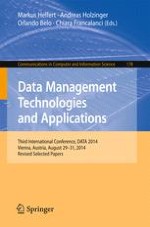2015 | Buch
Data Management Technologies and Applications
Third International Conference, DATA 2014, Vienna, Austria, August 29-31, 2014, Revised Selected papers
herausgegeben von: Markus Helfert, Andreas Holzinger, Orlando Belo, Chiara Francalanci
Verlag: Springer International Publishing
Buchreihe : Communications in Computer and Information Science
